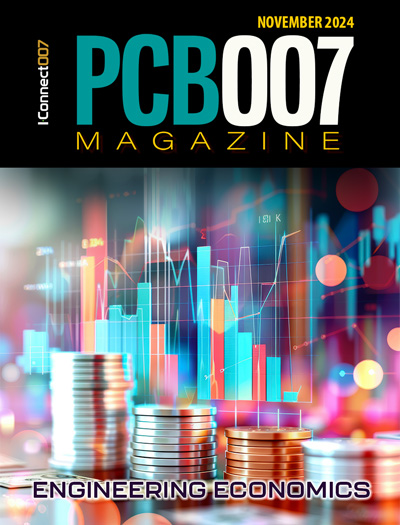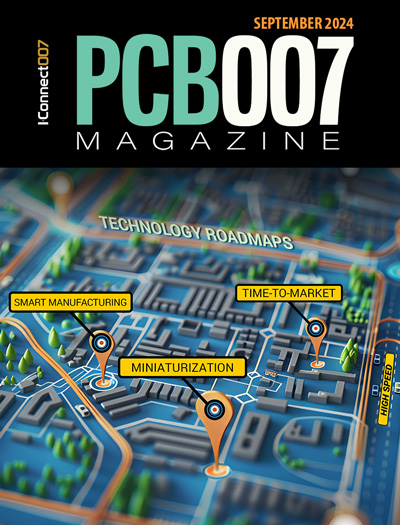-

- News
- Books
Featured Books
- pcb007 Magazine
Latest Issues
Current Issue
Engineering Economics
The real cost to manufacture a PCB encompasses everything that goes into making the product: the materials and other value-added supplies, machine and personnel costs, and most importantly, your quality. A hard look at real costs seems wholly appropriate.

Alternate Metallization Processes
Traditional electroless copper and electroless copper immersion gold have been primary PCB plating methods for decades. But alternative plating metals and processes have been introduced over the past few years as miniaturization and advanced packaging continue to develop.

Technology Roadmaps
In this issue of PCB007 Magazine, we discuss technology roadmaps and what they mean for our businesses, providing context to the all-important question: What is my company’s technology roadmap?
- Articles
- Columns
Search Console
- Links
- Media kit
||| MENU - pcb007 Magazine
Cost-optimize Your PCB Design and Specifications
August 20, 2024 | Erik Pedersen and Richard Koensgen, ICAPE GroupEstimated reading time: 1 minute
Knowledge is the key to identifying the small details that makes the big cost difference for your printed circuit board. There are many types of printed circuit boards and multiple choices between the development of schematic and BOM to PCB technology selection, electronic PCB design, mechanical and physical properties, and PCB specification.
Component Technology and BGA Size
The component size and technology have the most significant influence on the PCB cost. Most surface-mounted microchips can be designed into standard PCBs with plated through-holes. If the same microchip comes in a BGA package, it might need microvias and buried vias using a higher wiring density to be designed into an HDI PCB. Generally, PCBs containing BGAs become HDI PCBs when the ball center-to-center pitch is below 0.8 mm. If your physical board properties allow it and the component availability is equal, you should strive to find the BGA with the largest pitch to reduce the component and PCB cost.
For example, the same BGA microchip can be found with pitch 0.8 mm, 0.6 mm, and 0.5 mm. The 0.8 mm pitch BGA can be routed on an eight-layer standard PCB with a price index of 100. The 0.6 mm pitch can be routed on a (1-6-1) eight-layer, one-step HDI PCB with a price index of 200. The 0.5 mm pitch BGA can be routed on a (2-4B-2) eight-layer, three-step HDI PCB with a price index of 350. The number of lamination steps is the most significant cost driver for HDI and ultra HDI PCBs. Designs with BGAs equal to or less than 0.4 mm and multiple rows challenge the capability of HDI suppliers, which leads to the use of UHDI design parameters and thereby reduces the availability and increases the cost.
Material Selection
Correct material selection that complies with the performance and functionality of your application also plays a crucial role in the PCB cost.
The most common stackups of standard PCBs are specified with 35 µm Cu on all layers. The manufacturer starts on 17.5 µm Cu on outer layers and 35 µm Cu on inner layers, since the final outer layer Cu thickness reaches approximately 35 µm after plating. But 35 µm Cu on the inner layers isn’t always required and can be replaced by 17.5 µm for the current flowing in many electronic devices. This, in turn, lowers costs.
To continue reading this article, which originally published in the August 2024 Design007 Magazine, click here.
Suggested Items
I-Connect007 Editor’s Choice: Five Must-Reads for the Week
11/22/2024 | Andy Shaughnessy, I-Connect007In this week’s roundup, I’m highlighting a variety of articles. We have an interview with Jess Hollenbaugh, a recent graduate working for Polar Instruments. We also have an interview with IPC’s Matt Kelly and Devan Iyer, whose white paper may provide a way forward for companies dealing with complex advanced packages. Our newest columnist Tom Yang describes the U.S. PCB industry from the point of view of a technologist from another country, and Dan Beaulieu has a review of Malcolm Gladwell’s follow-up to The Tipping Point. Finally, we have my review of PCB Carolina, a one-day tabletop show that keeps expanding, much like my waistline after eating their catered food. Enjoy!
North American PCB Industry Sales Down 11.1% in October
11/22/2024 | IPCIPC announced today the October 2024 findings from its North American Printed Circuit Board (PCB) Statistical Program. The book-to-bill ratio stands at 1.09.
Real Time with... electronica 2024: Inside CEE PCB—Innovations in Technology
11/22/2024 | Real Time with... electronicaMarcy LaRont Interviews Tom Yang and Jerome Larez From CEE PCB. Tom and Jerome showcase the company's advancements and emphasize the importance of automation in PCB manufacturing for quality and efficiency. The CEE PCB focuses on sustainability and aims to connect with high-tech clients while exploring new partnerships for high-volume production.
Designing for Cost to Manufacture
11/21/2024 | Marcy LaRont, I-Connect007ICAPE's Richard Koensgen, a seasoned field application engineer with a rich background in PCB technology, shares his journey of working with customers and manufacturers through the intricacies of circuit board development and emphasizes the importance of early-stage collaboration with PCB designers. With a focus on tackling the most challenging aspects of PCB design and manufacturing, he discusses everything from layout considerations to the thermal challenges of today's technology when it comes to designing for cost.
PCB Design Software Market Expected to Hit $9.2B by 2031
11/21/2024 | openPRThis report provides an overview of the PCB design software market, detailing key market drivers, challenges, technological advancements, regional dynamics, and future trends. With a projected compound annual growth rate (CAGR) of 13.4% from 2024 to 2031, the market is expected to grow from USD 3.9 billion in 2024 to USD 9.2 billion by 2031.


